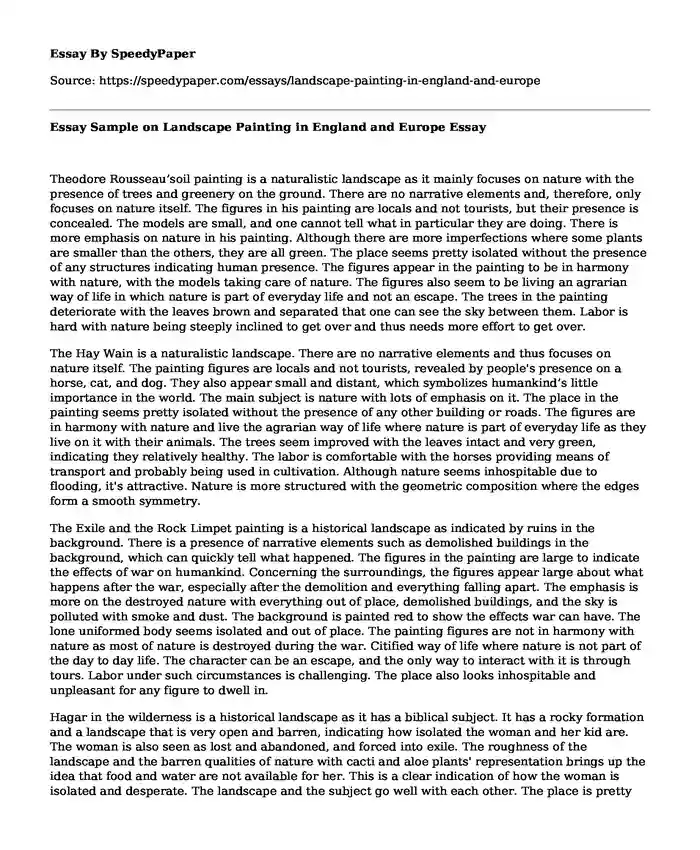Theodore Rousseau’soil painting is a naturalistic landscape as it mainly focuses on nature with the presence of trees and greenery on the ground. There are no narrative elements and, therefore, only focuses on nature itself. The figures in his painting are locals and not tourists, but their presence is concealed. The models are small, and one cannot tell what in particular they are doing. There is more emphasis on nature in his painting. Although there are more imperfections where some plants are smaller than the others, they are all green. The place seems pretty isolated without the presence of any structures indicating human presence. The figures appear in the painting to be in harmony with nature, with the models taking care of nature. The figures also seem to be living an agrarian way of life in which nature is part of everyday life and not an escape. The trees in the painting deteriorate with the leaves brown and separated that one can see the sky between them. Labor is hard with nature being steeply inclined to get over and thus needs more effort to get over.
The Hay Wain is a naturalistic landscape. There are no narrative elements and thus focuses on nature itself. The painting figures are locals and not tourists, revealed by people's presence on a horse, cat, and dog. They also appear small and distant, which symbolizes humankind’s little importance in the world. The main subject is nature with lots of emphasis on it. The place in the painting seems pretty isolated without the presence of any other building or roads. The figures are in harmony with nature and live the agrarian way of life where nature is part of everyday life as they live on it with their animals. The trees seem improved with the leaves intact and very green, indicating they relatively healthy. The labor is comfortable with the horses providing means of transport and probably being used in cultivation. Although nature seems inhospitable due to flooding, it's attractive. Nature is more structured with the geometric composition where the edges form a smooth symmetry.
The Exile and the Rock Limpet painting is a historical landscape as indicated by ruins in the background. There is a presence of narrative elements such as demolished buildings in the background, which can quickly tell what happened. The figures in the painting are large to indicate the effects of war on humankind. Concerning the surroundings, the figures appear large about what happens after the war, especially after the demolition and everything falling apart. The emphasis is more on the destroyed nature with everything out of place, demolished buildings, and the sky is polluted with smoke and dust. The background is painted red to show the effects war can have. The lone uniformed body seems isolated and out of place. The painting figures are not in harmony with nature as most of nature is destroyed during the war. Citified way of life where nature is not part of the day to day life. The character can be an escape, and the only way to interact with it is through tours. Labor under such circumstances is challenging. The place also looks inhospitable and unpleasant for any figure to dwell in.
Hagar in the wilderness is a historical landscape as it has a biblical subject. It has a rocky formation and a landscape that is very open and barren, indicating how isolated the woman and her kid are. The woman is also seen as lost and abandoned, and forced into exile. The roughness of the landscape and the barren qualities of nature with cacti and aloe plants' representation brings up the idea that food and water are not available for her. This is a clear indication of how the woman is isolated and desperate. The landscape and the subject go well with each other. The place is pretty secluded as there are no roads or buildings that indicate human presence in the area. The figure also seems to be in harmony with nature. There is also nationalist symbolism where the painter uses the oak tree, a national symbol in France.
Casper David Friedrich's Wanderer above the sea of fog is an oil painting that is a naturalistic landscape that has no narrative element and therefore only focuses on nature. The figures are locals, and the painter in his painting reveals them. Sculptures are large in his picture to show the more significant role of humans in nature. There is more emphasis on character, which occupies most of his artwork. The figures seem to be in harmony with nature. Labor in the area is challenging, with steep, sharply inclined to make it hard and to require lots of effort to scale. The landscape looks inhospitable and unpleasant. The fog can be cold, especially up the mountains.
Cite this page
Essay Sample on Landscape Painting in England and Europe. (2024, Jan 27). Retrieved from https://speedypaper.com/essays/landscape-painting-in-england-and-europe
Request Removal
If you are the original author of this essay and no longer wish to have it published on the SpeedyPaper website, please click below to request its removal:
- Metallica's Impact on Popular Culture, Music Essay Sample
- Research Paper Sample on the Use of Music in Teaching and Learning
- Essay Example: Eccentric Harajuku Fashion in West Coast
- Free Essay with the Analysis Report: "The Last Great Clothing Store"
- Essay Sample on "Pepsico.'s Live for Now"
- Disparities in Healthcare. Free Essay
- The Idea of Justice and Egalitarianism - Essay Example
Popular categories





